American Basswood Trees (American Linden): Types, Leaves, Flowers – Identification (Pictures)
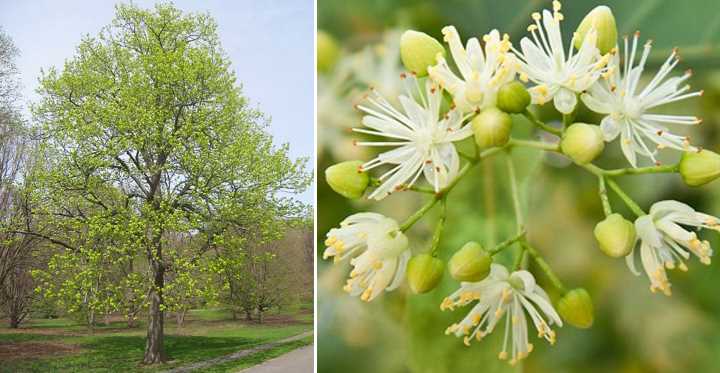
The American basswood tree (Tilia americana) is a large, fast-growing deciduous flowering tree with fragrant yellowish-white flowers, large ovate leaves, and a domed crown. Also named American linden, the American basswood tree is a popular ornamental shade tree due to its dense foliage and spreading canopy. Additionally, basswood trees are popular with beekeepers due to the excellent honey bees produce from the flowers’ nectar.
The American basswood tree is the only native North American species in the genus Tilia. Other tree species in the genus Tilia are known as linden trees. In Europe, linden trees are called lime trees. Popular linden varieties include the common linden (Tilia x europaea), silver linden (Tilia tomentosa), and the little-leaf linden (Tilia cordata).
This article is a comprehensive guide to the native American basswood tree. Descriptions and pictures of American linden trees will help identify this majestic shade tree.
What is American Basswood (American Linden) Tree?
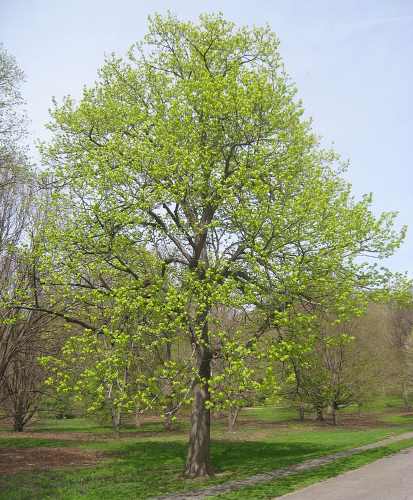
American Basswood tree
The American basswood is the only North American native species in the Tilia genus of flowering trees. The American linden is one of the fastest-growing hardwood trees in the US. American basswood grows for around 200 years and is often found growing in eastern and central North America.
Basswood Tree Leaves
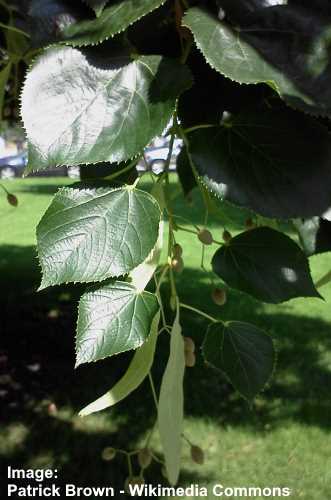
Basswood tree leaves
American basswood leaves are distinctive heart-shaped leaves, recognizable by their serrated edges and pointed tip. The basswood leaves are asymmetrical—meaning the base is somewhat lopsided. The leaves grow between 4” and 8” (10 – 20 cm) long and up to 6” (15 cm) wide. American basswood leaves are larger than the European linden varieties.
The ovate, coarsely toothed basswood leaves are arranged alternately on branches. During the growing season, the leaves have a dark green upper side and light pale-green underside. In fall, the leaves of deciduous basswood trees turn pale yellow to yellowish-green.
Basswood Tree Flowers
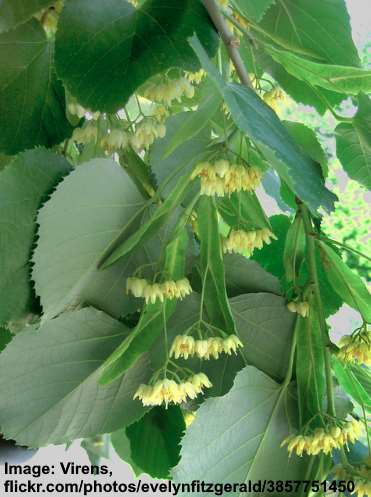
Basswood tree flowers and above them are green narrow leaf-like bracts
American basswood flowers are one of the most identifiable features of the tree. Basswood trees have tiny nectar-rich, fragrant yellowish-white blossoms that dangle in clusters, attached to the tree by a strap-shaped bract. Each bunch of basswood tree flowers has 6 to 20 flowers, each measuring about 0.4” (1 cm).
The long, pale, green leaf-like bracts above the flower clusters are the unique identifying feature of American basswood trees.
American basswood flowers bloom in early summer and may persist until fall. After blooming, the flowers develop into basswood fruit. These small, globular green nutlets also grow in clusters on the ends of the dried long, tongue-shaped bracts.
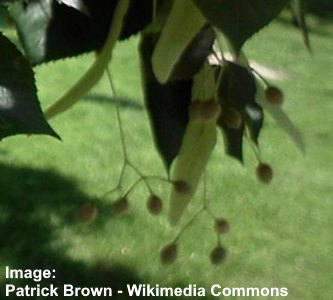
Close up picture on basswood fruit (nutlets)
American basswood flowers are famous for attracting honeybees. The nectar from the tree’s flowers produces high-quality honey. Many beekeepers even plant basswood trees because of their fragrant flowers and the excellent honey bees make.
Basswood Tree Bark

Basswood tree bark
American basswood bark is identified as gray to gray-brown, and sometimes, almost black. Immature basswood bark looks smooth and gray with fine ridges. As the tree matures, basswood bark becomes darker and fissured, taking on a rough, scaly texture. You can spot deep, irregular furrows running vertically on basswood trees.
Basswood Tree Fruit
American basswood fruit is a group of small round nut-like balls, with each nut measuring up to 0.4” (1 cm) in diameter. The small rounded nuts grow in open clusters and have a fuzzy coating. On some trees, the basswood nuts look white; on others, they are green. An identifying feature of basswood fruit is the tongue-like bracts that fruit clusters dangle from.
Basswood Tree Identification

American basswood bract, flowers and leaf
Identify American basswood trees by their clusters of creamy or yellowish fragrant flowers attached to long leaf-like bracts. A characteristic of basswoods is their large heart-shaped, asymmetrical leaves with coarsely serrated margins and pointed tips. Another identification feature of basswood trees identification is their silvery-gray bark on young trees that becomes furrowed, rough, and dark gray.
In landscapes, you can spot basswood trees by their oval to oblong-shaped crown consisting of dense foliage and huge broad ovate leaves.
Basswood Tree Uses
American basswood timber has several uses due to its workability. Basswood timber is relatively soft and doesn’t split easily, and is a cheap type of wood for making furniture, wooden boxes, and cabinets. The American linden wood is also ideal for carving.
Basswood trees are also a source of high-quality honey. The rich nectar in the flowers attracts multitudes of honeybees throughout the summer. So delicious is the honey that it’s sold as basswood honey.
How to Care for Basswood Tree (American Linden)
To care for an American basswood tree, grow the ornamental tree in full sun and moist ground with excellent drainage. The beautiful American linden tree is low-maintenance and requires little to no pruning. Mulch around the trunk to lock in moisture and prevent weeds from growing. Only water the basswood tree during prolonged dry periods.
Types of Basswood Trees (Tilia americana)
The primary species of basswood is the American basswood (Tilia americana). There are also several cultivars in the species, each with its own unique growing characteristics.
American Basswood (Tilia americana)
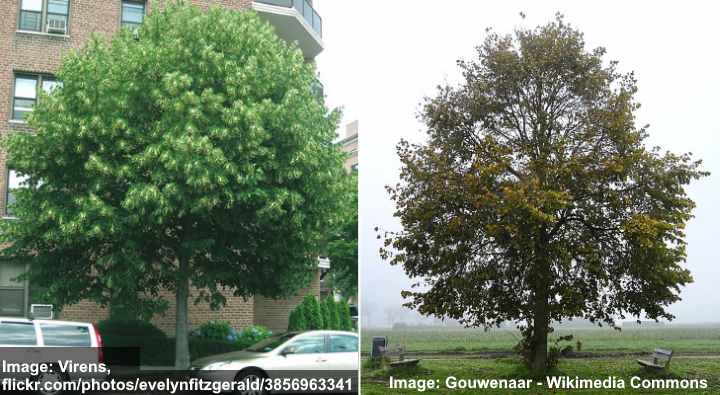
American basswood (Tilia americana) trees
The American basswood is a tree species in the linden tree genus Tilia and mallow (hibiscus) family Malvaceae. The American linden (basswood) is the most common of the Tilia species in the US. It’s a large deciduous ornamental shade tree that boasts some of the largest leaves among native species.
Stately American basswood trees thrive in USDA zones 3 – 8. However, they may also grow in sheltered areas of zone 2. The imposing tree with its vast spreading rounded, pyramidal crown grows between 50 and 80 ft. (15 – 24 ft.) tall and 30 to 50 ft. (9 – 15 m) wide.
Due to the vast size of basswood trees, you need plenty of room to grow them in a backyard. The linden trees are popular as shade trees, tall privacy hedges, and street trees. However, the ornamental landscape basswood trees are not tolerant to air pollution and urban conditions.
The American basswood is among the largest hardwood, deciduous trees in eastern and central North America. The tree is an important source of lumber in the Great Lake states. You can find the American lindens growing as far west and north as Minnesota and east on the Atlantic coast. Toward the south, basswood trees are found in certain areas to Tennessee and North Carolina.
American basswood leaves are some of the largest of all the broadleaf trees in the US. The huge heart-shaped leaves are easy to spot with their rough, serrated margins, pointed tip, and prominent yellowish veins. Some of the larger linden leaves are bigger than your hand. This characteristic of basswood trees adds to their appeal as shade trees.
American basswood flowers are prized for their rich nectar and sweet fragrance. It’s easy to spot basswood trees when in bloom during the summer. Clusters of fuzzy-looking globular flowers hang off long bracts.
Small basswood fruits appear on the trees after the foliage has turned pale yellow and dropped in the fall. The brown clusters of small roundish nuts dangle from brown, dried bracts.
Popular American Basswood Cultivars
Here is information about some of the most common Tilia americana (American basswood) cultivars:
Carolina Basswood (Tilia americana var. caroliniana): This American basswood cultivar is smaller than the species tree, only growing between 50 and 80 ft. (15 – 24 m) tall. The broad, serrated ovate leaves are less rounded and more diamond-shaped. Carolina basswoods typically grow on the southern east coast of the US from North Carolina to Florida.
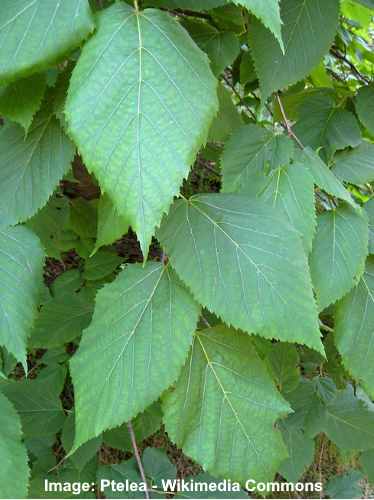
Carolina basswood leaves are diamond shaped
Redmond Basswood (Tilia americana ‘Redmond’): The identifying feature of this basswood cultivar is its dense foliage and pyramidal shape. This basswood grows up to 35 ft. (10 m) tall.
White Basswood (Tilia americana var. heterophylla): The American linden has serrated leaves with whitish undersides, giving the tree’s foliage a whitish appearance. You’ll find these linden trees growing from Missouri to Alabama.
Boulevard American Basswood (Tilia americana ‘Boulevard’): This is a tall, narrow linden tree that grows up to 50 ft. (15 m). You can spot this tree due to its narrowly pyramidal growth.
Lincoln Linden (Tilia americana ‘Lincoln’): This American basswood cultivar has a rounded, pyramidal shape and dense, dark green foliage. The linden tree grows up to 35 ft. (10 m) tall and 25 ft. (7.5 m) wide.
Legend American Basswood (Tilia americana ‘DTR 123’): This basswood is identified by its broadly pyramidal growth and glossy, dark green foliage. In winter, the cultivar has bright red winter buds and twigs.
American Basswood (Tilia americana) Care Guide
American linden trees are giant shade trees, popular in sizeable residential garden landscapes. Let’s look in more detail at how to care for these majestic ornamental trees.
Where to Plant American Basswood Tree
Grow American basswood trees in a sunny part of your backyard. Basswood trees grow best when they get at least six hours of sun daily. However, the trees will also withstand some shade.
When choosing a location to plant a basswood tree, remember that this is an imposing ornamental tree. American basswoods grow up to 80 ft. (24 m) tall and 50 ft. (15 m) wide.
The best time to plant an American linden is in the fall. Plant the bare root tree in a hole so that that soil line is in line with the ground. Fill in the empty space with organically rich soil and water well. For the first three months, water a newly-planted basswood once or twice a week. Mulching around the trunk also helps lock in moisture to the ground.
The Best Soil for Growing American Linden Trees
American basswood trees grow best in neutral to alkaline soils. However, they will perform well in slightly acidic soil. As long as the nitrogen-hungry tree gets enough moisture and sunlight, it should grow well in most landscapes.
How to Water American Basswood Trees
American linden trees are relatively tolerant of drought. For the basswood tree to thrive, it’s essential to keep the ground moist but not soggy. During particularly dry spells, water the soil regularly to keep it moist. However, during other times, you don’t need to add additional water.
To create the ideal conditions for the linden tree, add 4” (10 cm) of mulch around the root area. Keep a space of about 2” (5 cm) free from mulch around the trunk to prevent rot.
American Basswood Growth Rate
American basswood trees are fast-growing, deciduous trees that grow 2 ft. (0.6 m) per year. On average, American basswood trees take 20 years to grow 20 or 30 ft. (6 – 9 m) tall. A mature basswood tree eventually grows between 50 and 80 ft. (15 – 24 m) high.
How to Fertilize American Basswood Tree
American basswood trees require plenty of nitrogen in the ground to grow best. For newly planted basswood trees, put a layer of organic compost around the root base. About 1” to 2” (2.5 – 5 cm) should be fine. Rotted manure is also excellent for basswood trees as it’s rich in nitrogen.
Fertilize a basswood tree every one to two years in spring, usually in April or May. If the tree has grown at least 6” (15 cm) since the previous year, you may not need to fertilize it.
If you decide to use a slow-release fertilizer, then choose one with an NPK rating of 18-6-12. Apply the fertilizer to a circle equal to at least twice the height of the basswood tree.
Pruning American Basswood Trees
American basswood trees growing in residential landscapes benefit from occasional pruning. Every winter, remove weak or dead branches from the linden tree. It’s also a good idea to trim branches that grow toward the crown’s center.
Prune young, newly planted linden trees in the summer to encourage new growth. During the tree’s first four years, remove any branches that grow towards the center of the crown or that rub on other branches.
It may be necessary to remove any suckers that grow from the ground to prevent multiple stems from growing.
Pests Affecting Basswood Tree Growth
Japanese beetles are common pests affecting American linden trees. However, linden looper caterpillars, basswood leaf miners, and fall webworms can all infest linden trees. Usually, these common leaf feeders will attack foliage, causing leaves to look unsightly.
Additionally, aphids can feed on small twigs and produce a sticky honeydew substance that can attract ants to your garden. Honeydew can be a reason for linden trees to develop dark sooty mold. Also, watch out for linden mites and scale insects.
Related reading: How to get rid of leaf miners.
Diseases Affecting American Basswood Trees
Fungal infections such as anthracnose leaf blight and powdery mildew can cause basswood leaves to wilt and drop from the tree prematurely. Leaf blight looks like black or brown spots on leaves. You can spot the signs of powdery mildew by a white, flour-like substance on leaves.
Related articles:
